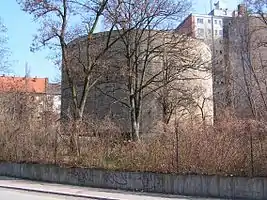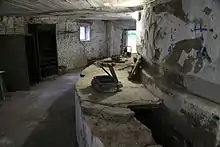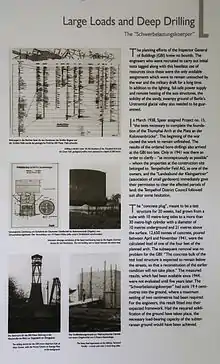Schwerbelastungskörper
The Schwerbelastungskörper (German: "heavy load-bearing body";[1] a.k.a. Großbelastungskörper - GBK) is a hefty concrete cylinder located at the intersection of Dudenstraße, General-Pape-Straße, and Loewenhardtdamm in the northwestern part of the borough of Tempelhof in Berlin, Germany. It was built by Hitler's chief architect Albert Speer to determine the feasibility of constructing large buildings on the area's marshy, sandy ground. Erected between 1941 and 1942 it was meant to test the ground for a massive triumphal arch on a nearby plot. The arch, in the style of the Nazi architectural movement, was to be about three times as large as the Arc de Triomphe in Paris. It was one component of a plan to redesign the center of Berlin as an imposing, monumental capital reflecting the spirit of the Nazi Germany as envisioned by Hitler.[2]



The Schwerbelastungskörper was built by Dyckerhoff & Widmann AG in 1941 at a cost of 400,000 Reichsmark. At the fixed exchange rate of 4.2 RM per USD, 400,000 RM was worth $95,200, which is equivalent to $1,290,000 in 2019. It consists of a foundation with a diameter of 11 m (36 ft) that reaches 18.2 m (60 ft) into the ground and contains rooms which once housed instruments to measure ground subsidence caused by the weight of the cylinder, which was estimated as equivalent to the load calculated for one pillar of the intended arch. On this foundation a cylinder 14 m (46 ft) high and 21 m (69 ft) in diameter weighing 12,650 tonnes was erected at street level. The entire construction puts 1.24 MPa (180 psi) of pressure on an area of 100 m2 (1,100 sq ft). If it were to sink less than 6 cm (2.4 in), the soil would be deemed sound enough for further construction without additional stabilization. The cylinder itself was to be subsequently buried under an artificial hill upon which the triumphal arch was to be erected, enabling a panoramic view down a new wide north-south axis to a huge assembly hall to be constructed near, and dwarfing the Brandenburg Gate.[3]
Work on the new capital was soon discontinued because of World War II and measurements at the cylinder ceased in June 1944. An analysis of the meticulous measurements only took place in 1948, revealing that the cylinder had sunk some 19 cm (7.5 in) after two and a half years. The arch as conceived by Speer could only have been built after considerable prior stabilization of the ground.
Removal of the cylinder was considered after the war to create new building sites, but because of its mass as well as nearby train tracks and apartment buildings the structure could not be safely demolished with explosives. Measurements of the subsidence were resumed and continued until 1977 under the auspices of the Technical University of Berlin as part of a project to compile data about the city's geologic foundation. Since 1995 the monumental cylinder has been protected as a historic monument. It is open to the public for viewing and guided tours.
References
- "Schwerbelastungskörper (Heavy Load-Bearing Body)". www.visitberlin.de. Retrieved 2020-09-25.
- "Hitler's Underground Lair". Cities of the Underworld. Season 1. Episode 3. 2007-04-30. History.
- Mythos Germania. Berlin: Edition Berliner Unterwelten. 2008. pp. 60–61. ISBN 978-3-86541-290-4.
Further reading
- Roger Moorhouse, Berlin at War: Life and Death in Hitler's Capital, 1939-1945, Bodley Head, 2010.
External links
| Wikimedia Commons has media related to Schwerbelastungskörper (Berlin-Tempelhof). |